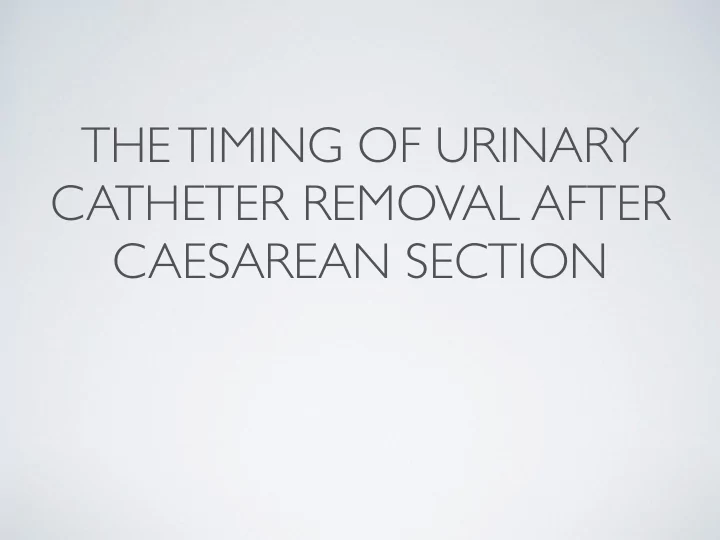

THE TIMING OF URINARY CATHETER REMOVAL AFTER CAESAREAN SECTION
WHY INSERT A CATHETER FOR C-SECTION? • Emptying the bladder helps protect it from injury during surgery • Emptying the bladder improves visualisation of the surgical field • Central neuraxial blocks (spinal, epidural) can cause urinary retention and distension injuries
CATHETER COMPLICATIONS • Increased incidence of UTI • Urethral pain • Voiding difficulties following removal • Delayed mobilisation • Increased length of hospital stay
THE AUDIT • Aim: To help inform best practice regarding the timing of urinary catheter removal after caesarean section • 2 sets of data to present (both for low risk, elective cases) • Pre enhanced recovery - March 2014 • Post enhanced recovery - December 2014
FIRST DATA SET • Data collection from 4 th March to 4 th April • Midwives to complete data collection form • 42 women • 31 (74%) women with complete data collection form
14 12 10 Number of women 8 6 4 2 0 0-2 2-4 4-6 6-8 8-10 10-12 12-14 14-16 16-18 18-20 20-22 22-24 24-26 26-28 28-30 Length of time urinary catheter in-situ (hours) Mean 17.8, SD 3.5 Median 19.0, IQR 4.6 (15-19.6)
Number of women 10 12 14 16 18 20 22 0 2 4 6 8 00:00 - 02:00 02:00 - 04:00 04:00 - 06:00 06:00 - 08:00 Time of day of urinary catheter removal 08:00 - 10:00 10:00 - 12:00 12:00 - 14:00 14:00 - 16:00 16:00 - 18:00 18:00 - 20:00 20:00 - 22:00 22:00 - 00:00
RECATHETRISATION • 2 women • Rate of 4.8% to 6.5% (optimistically)
SECOND DATA SET • Data collection December 2014 • Data collection from the post-natal care plan • 27 women
18 16 14 12 Number of women 10 8 6 4 2 0 0-2 2-4 4-6 6-8 8-10 10-12 12-14 14-16 16-18 18-20 20-22 22-24 24-26 26-28 28-30 Length of time urinary catheter in-situ (hours) Mean 9.8, SD 5.7 Median 7.0, IQR 5.0 (6.0-11.0)
FIRST DATA SET VERSUS SECOND DATA SET First data set Second data set Mean 17.8 9.8 SD 3.5 5.7 Median 19 7 IQR 4.6 5 Introduction of the enhanced recovery program: → Reduction in length of time urinary catheters in-situ → Urinary catheters no longer simply removed at a convenient time
UNANSWERED QUESTIONS • Why aren’t all women having their catheters removed at 6 hours as per the enhanced recovery program? • Has the earlier removal of catheters led to a change in the rate of re-catheterisation?
WHY AREN’T ALL WOMEN HAVING THEIR CATHETERS REMOVED AT 6 HOURS AS PER THE ENHANCED RECOVERY PROGRAM? • 8 women with catheter in-situ for more than 10 hours • 2 due to postpartum bleeding • 2 surmised due to postpartum bleeding • 2 due to women’s request • 2 no clear reason
HAS THE EARLIER REMOVAL OF CATHETERS LED TO A CHANGE IN THE RATE OF RE-CATHETERISATION? • 2 women • Rate of 7.4% (compared to first data set of 4.8-6.5%)
CONCLUSIONS • The introduction of the enhanced recovery program for low risk women undergoing caesarean section has led to a reduction in the length of time that urinary catheters are in-situ without increasing the need for re-catheterisation • Note: Ongoing data collection is now underway to capture all women undergoing caesarean section, not just low risk, elective cases
ANY QUESTIONS?
Recommend
More recommend